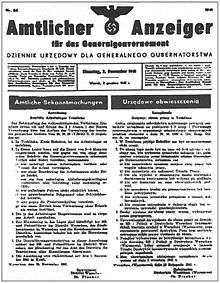Theodor van Eupen
| Theodor van Eupen | |
|---|---|
|
Historic site of Treblinka I Arbeitslager run by Eupen; memorial stone. | |
| Born |
24 April 1907 Düsseldorf, Germany |
| Died |
14 December 1944 (aged 37) Lipówka, near Jędrzejów, Poland*.[1] |
| Allegiance |
|
| Service/branch |
|
| Rank |
|
| Unit |
|
| Commands held | Deputy commandant of Treblinka extermination camp |
SS-Sturmbannführer Theodor van Eupen (24 April 1907 – 14 December 1944) was a Holocaust perpetrator, commandant (SS Major) of the infamous Treblinka I forced-labour camp (Arbeitslager) in occupied Poland during its entire course of operation. Unlike the parallel Treblinka II extermination camp subordinate to the Operation Reinhard authorities in Berlin, Treblinka I was controlled by the SS and Police Leader in Warsaw.[2] The labour camp was liquidated on 23 August 1944, ahead of the Soviet advance. By then, more than half of its cumulative number of some 20,000 inmates had died from summary executions, hunger, disease and mistreatment.[3] The regular workforce consisted of 1,000–2,000 prisoners, terrorized by staff of about a dozen SS-men and 100 Wachmänner guards.[4]
World War II career
Born in Düsseldorf, van Eupen received a law degree before World War II similar to other notable members of the Nazi Party such as Hans Frank, head of the semi-colonial General Government.[5][6] Theodor van Eupen joined the Schutzstaffel with the card number 4528. After the invasion of Poland he was promoted to the position of Commandant of Treblinka I in the summer of 1941, ahead of the camp's official founding which took place in November 1941. He supervised the building of barracks as well as barbed wire fencing 2 metres (6 ft 7 in) tall, around the perimeter.[4]

Treblinka I was a gravel quarry equipped with heavy machinery, essential to the production of concrete and road construction. Before the German occupation, the mega quarry was owned by the Polish industrialist Marian Łopuszyński who built a railway track connecting the mine with Małkinia–Sokołów Podlaski junction. Setting up a penal colony there was the idea of Sturmbannführer Ernst Gramss who first ran it as his own personal business venture in occupied Poland. The quarry became vital during the German attack on the Soviet Union, supplying gravel for the strategic road-building programme around the German–Soviet border.[4][7]
Van Eupen was in charge of Treblinka I officially from 15 November 1941 (date of the camp's founding by Warsaw SS Governor Dr. Ludwig Fischer), until its closing on 23 July 1944. He worked closely with the SS and police commandanture in Warsaw during the deportation of Jews to the gas chambers of Treblinka II in early 1943, in order to have the slave labour brought to him from the Warsaw Ghetto for necessary replacements. He claimed to have been a German-Dutch aristocrat and liked to have his wife and two little sons visit him in occupied Poland. Van Eupen was feared even by his own SS subordinates penalized by being sent to the Eastern Front for even the smallest infractions. He arranged to have a garden built by his house with a pond and water fowl.[4]
Reportedly well-mannered,[4] van Eupen nevertheless had a reputation of a notorious sadist who often personally executed prisoners,[6] "taking shots at them, as if they were partridges" wrote Franciszek Ząbecki, the Polish station master.[7] Prisoners who worked 12- to 14-hour shifts received watery soup for breakfast, similar soup for lunch, and the roasted-grain beverage with rye bread for supper, each loaf shared by the 10 of them. During the liquidation of the camp, some 500–700 inmates were executed by the SS in the forest, and all structures were burned to the ground.[4] Theodor van Eupen's luck ended shortly thereafter. He was killed by Polish partisans near Jędrzejów in mid December 1944,[7] ambushed on the road. He jumped out of the car and ran on foot as far as Lipówka village where he crawled under a pile of hay. The partisans machine-gunned his hiding place and learned who he was only from the documents they found on his corpse.[4]
References
- ↑ Stefan Sokołowski, Dzielnica "Nida", Feniks Koszalin, 1994, s.166
- ↑ Holocaust Encyclopedia (2010). "Treblinka". Washington, D.C.: United States Holocaust Memorial Museum. Archived from the original (Internet Archive) on 5 August 2011. Retrieved 20 November 2013.
- ↑ Maranda, Michał (2002). "Więźniowie obozu zagłady w Treblince" [Prisoners of Treblinka death camp] (PDF). Nazistowskie Obozy Zagłady. Opis i próba analizy zjawiska (Nazi extermination camps. Analysis) (in Polish). Uniwersytet Warszawski, Instytut Stosowanych Nauk Społecznych (Warsaw University Institute of Social Sciences). pp. 160–161. ISBN 83-915036-6-6. Retrieved 15 December 2013.
- 1 2 3 4 5 6 7 Kopówka, Edward; Rytel-Andrianik, Paweł (2011), "Treblinka II – Obóz zagłady" [Monograph, chapt. 3: Treblinka II Death Camp] (PDF file, direct download 20.2 MB), Dam im imię na wieki [I will give them an everlasting name. Isaiah 56:5] (in Polish), Drohiczyńskie Towarzystwo Naukowe [The Drohiczyn Scientific Society], pp. 37–39, 42, 54, 60, ISBN 978-83-7257-496-1, retrieved 9 September 2013,
with list of Catholic rescuers of Jews imprisoned at Treblinka, selected testimonies, bibliography, alphabetical indexes, photographs, English language summaries, and forewords by Holocaust scholars.
- ↑ Robert S. Wistrich (2013). Who's Who in Nazi Germany (Google Books search inside). Routledge. ISBN 113641388X. Retrieved 20 November 2013.
- 1 2 Cywiński, Piotr (2013). "Treblinka". Diapositive.pl online Holocaust museum. Jewish Identity and Culture in Poland. Adam Mickiewicz Institute. Retrieved 31 October 2013.
See also: Camps: Typological Differences.
- 1 2 3 S.J., H.E.A.R.T (2007). "SS-Sturmbannfuhrer Theodor van Eupen". Labour Camps – Belzec , Sobibor and Treblinka. Holocaust Education & Archive Research Team. Retrieved 20 November 2013.
- Obóz w Treblince Izrael.Badacz.org (Polish)
 Media related to Treblinka extermination camp at Wikimedia Commons
Media related to Treblinka extermination camp at Wikimedia Commons